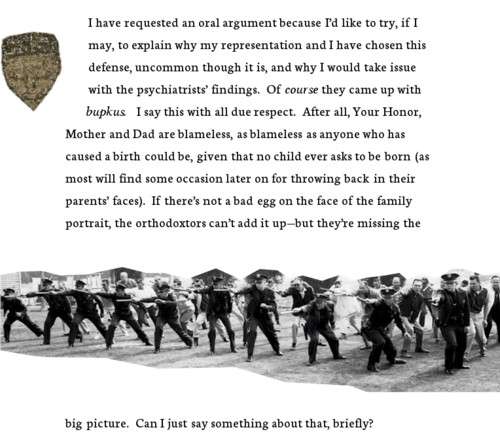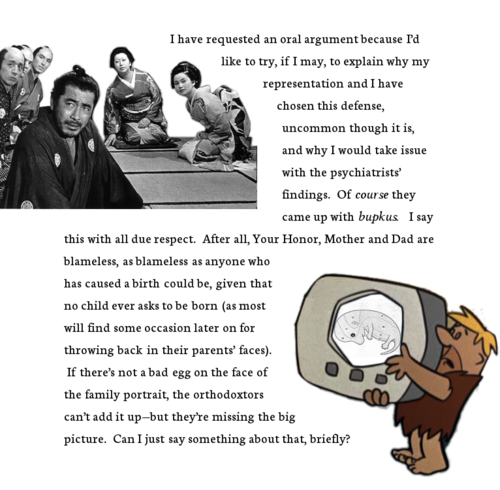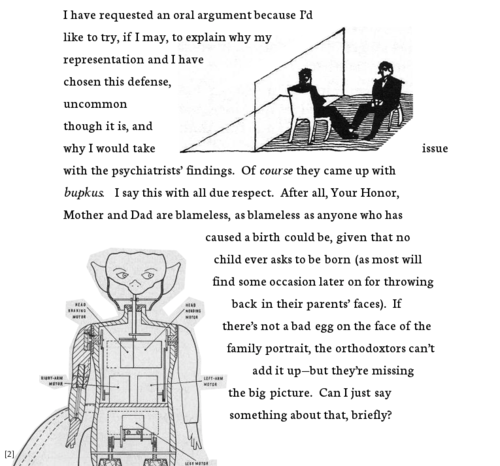
(One of the 340,068,392 variations on the first page of Alexandra Chasin’s novella for the iPad, Brief)
It seemed like a good idea to talk to my friend Alexandra Chasin about her novella, Brief, published by Jaded Ibis Press. It’s generally a good idea to talk to Chasin as she’s a good talker and can speak intelligently on any number of subjects. In fact, she’s brilliant, but her brilliance is warm and inviting and inclusive, which seems perhaps more rare than it should be. She wants you to be a part of the conversation and, in fact, relies upon it in her work. Chasin’s fiction is playful and hilarious and at the same time dense and challenging.
Alexandra Chasin holds a 2012 Fellowship in Fiction from the New York Foundation for the Arts. She is Associate Professor of Literary Studies at Lang College, The New School. Selling Out (St. Martin’s, 2000) and Kissed By (FC2, 2007) are her previous books. Brief (Jaded Ibis, 2012) is her first work of literary fiction in app form.
Most of this particular conversation took place over email, though parts were conducted in Park Slope and Clinton Hill living rooms.
—Robert Lopez
I. ART AS A THING FRAMED
ROBERT LOPEZ: How did Brief get started? The interest in art vandalism comes from…
ALEXANDRA CHASIN: I’ve had a long-standing interest in art theft, art forgery, and art vandalism—violations of art norms. I like them because they expose the contradictions that structure the norms.
Maybe Brief started in graduate school, when I took a course in the Sociology of Culture, taught by Ann Swidler. Suddenly, it was possible to see art as a practice governed by social values, culturally variable values, art as a cipher or a fetish, art as a thing framed—the frame was the thing, and the structures on which art had been hanging all along came into focus. Suddenly my subjective response to art was predictable according to my race, class, gender, age, education. Suddenly it was acknowledged that art did not operate in isolation from the market, from political life, from the sphere of utility. Suddenly it all made sense. And this was in the 1980s, when the museums, curators, dealers, and collectors transformed art into the kind of commodity it still is, with the kind of price tag it still has. Art was an idea, a cluster of ideas that found meaning, or were made meaningful, in institutions that had long histories, sites where value is negotiated.
I was raised to believe in art as the great redeemer, to think that good and bad, genius and dabbler, were self-evident qualities that inhered in art objects and artists, respectively, to think that to know (if I could not make) great art would make me the best person I could possibly be, or better than others anyway. That last axiom was probably the first one to tip me off to the scam.
I now see art vandalism as one of many, many ways in which the value of art is negotiated. Along with legal and financial modes of negotiation—and forgery and theft. I think I thought Brief would be one of a triptych. Now I’m not so sure.
RL: So how did Brief get started as a work of fiction?
AC: I think the research determined the narrative. After I had taken a look at art vandalism in the West, I began to think, it’s easy to dismiss art vandals as crazy, but what if there’s something to learn from their rejection of art norms? What kind of social forces might propel someone to act out that rejection?
So the first gambit, for me, in writing Brief, was to explore the social determinism implied in that question, to play with an anti-psychoanalytic approach to history. Maybe we overvalue the role of family as determinants of individual personality and action, and are, in fact, more formed by cultural forces and historical events than we think. Who better than a fictional art vandal to carry that investigation?
The vandal needed a specific date of birth. What historical moment would spawn an art vandal? January 30, 1961. Brief unfolds around that date.
RL: Why is January 30, 1961 the date that would spawn an art vandal?
AC: Clearly, the trend away from text and toward image is long and complex, but I think of the early 1960s as the time of image saturation in the United States, the period in which television came into virtually all U.S. households, the moment in which heroic abstract expressionism yielded to mass-produced imagery, as manifest in op art and pop art. It was also a moment characterized by mass-mediated messages and images of the Cold War and Civil Rights, so the novella locates these cultural phenomena as determining influences, among others.
Brief is a fiction insofar as I wanted a made-up narrator with a specific date of birth to raise these questions, but I also wanted to play with the genre boundary and so Brief also incorporates a number of nonfictional texts, variously cited, including the result of Albert Bandura’s Bobo Doll Study, the script of The Battle of Algiers, coverage of the Algerian massacre in Paris, song lyrics, and more.
RL: So Brief is a narrative?
AC: I wanted to call Brief “a novella of ideas,” a la Milan Kundera, a la Thomas Mann. The word “novel” on the cover is a function of “marketing.”

II. REMEMBER THE PHONE BOOK?
RL: Okay, so what’s the deal with this as an app for iPad?
AC: The day I was done writing Brief, I realized that the text was all about images, image history, violence of and to images. Yet it had not one time occurred to me to make images part of the work. Now I wanted images, but I wanted them to evoke rather than illustrate. I could manipulate them, which I did—they are: torn up, composited, abstracted, etc. But could the images resist attachment to particular places in the text? Yes, in an app.
What the uber-talented Scott Peterman did was to create an app that randomly places images and then wraps the fixed text around them. So researching and manipulating images was also a huge part of making Brief; there is a cache of about 635, most with reference (more or less legible) to 1961.
RL: Are there any other reasons that an app is a fitting medium for Brief?
AC: Yes, the text of Brief poses questions about how history proceeds, probing questions of determinacy and contingency. The app, in randomizing the location of the images, also plays with questions of contingency—and then there’s the question of how any given configuration of images affects the reading of the text.
Finally, the narrator does something, late in the narrative that accounts for the random location of torn-up pieces of images in the text—but I won’t give it away.
Brief is actually available as a print book too. The book has great images and great design, but don’t worry—the images stay put.
RL: Your first collection of stories, Kissed By, one of my favorites, employs a variety of forms and formal innovations. With Brief too, it sounds like you’re focused on form and function. How do they work for you? Do you think of a form and find language, story, subject matter to fit into that form? Does the language, story, subject matter dictate the form? Or some combination of the two?
AC: Sometimes I start from language. I have nothing particular to say. I usually find my way round to meaning, but I’m not exactly sure why. And sometimes I don’t. Other times, I have something I want to say and I need to find language to say that something. Then it’s too easy to assume that standard conventions are called for, so I call all the language-surround-and-scaffold into question, from voice to spelling to genre (or discipline) to format. And in the case of Brief, medium. I often look for the kind of saying that says a certain something best.
But it goes the other way too. If I begin with arbitrary constraints, à la Oulipo, I find that they determine content (un-Oulipeanly), and if I start from content, I find that that will determine form, if I pay close attention. I tend to work toward an organic and NONarbitrary relationship between form and content. Making an assumption that content is best served by a sequence of wrap-around paragraphs supports an arbitrary relationship between form and content, just like transcribing the first word from the tops of pages in the phone book (remember the phone book?).
I’m reporting on my habits here, my proclivities, my commitments—there’s nothing prescriptive about it. I care passionately about ideas and politics and language, its meanings and sounds, and the repetition of the latter gratifies me immeasurably–these abstractions float my boat. Sometimes I drive, but when language takes the wheel, it turns the engine to idle in the middle of the lake. Put put, put put. Language doesn’t care if we ever get there. We bob around smelling the lyrical water lilies while the liquid lapis lazuli lightly slaps at the sides of the boat.
RL: Would you say you have an aesthetics, or an ethics perhaps, of possibility?
AC: Wow, yes, how did you do that?! And Brief is designed to manifest nothing if not possibility. 340,000,000 isn’t infinity, but it’s functionally similar, if that’s how many rolls it would take, on average, to roll the same screen twice.

You can see more info about the app for Brief here, and the paperback here.
Robert Lopez is the author of two novels, Part of the World and Kamby Bolongo Mean River and a collection of short fiction, Asunder.




